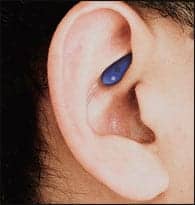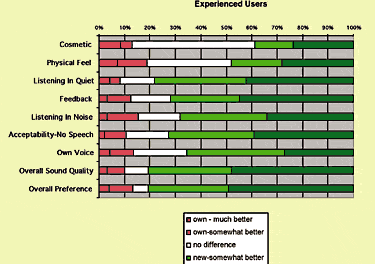In the development process for new hearing instruments, attention must be given to various aspects of the desired outcome. As a result, not all hearing instruments are designed for the same user group. Although cosmetics have always been a strong driver for successful solutions, it is not enough for hearing instruments today just to be small; they must also have an appealing design. Moreover, this must be accomplished without sacrificing the high-end processing features available in other products.
| This article was submitted to HR by Pamela Burton, AuD, director of Product Management, and Thomas A. Powers, PhD, VP Audiology & Professional Relations, at Siemens Hearing Instruments in Piscataway, NJ, and Josef Chalupper, PhD, Director of Audiology at Siemens Audiologische Technik, Erlangen, Germany. Correspondence can be addressed to [email protected] or Pamela Burton at . |
Recent research from MarkeTrak VII1 reveals that about 50% of people who admit to having a hearing loss choose not to use hearing instruments because of stigma issues. The primary reasons given are that hearing instruments are a noticeable admission of hearing loss and an embarrassment. Importantly, respondents also believe that the use of hearing instruments have the societal connotation of “disability” and “aging.”
For younger baby boomer individuals with hearing loss, stigma probably has an even greater effect than indicated in these data. Kochkin1 reports that, when an older person (~75 years old) and a younger person have the same degree of hearing loss, the older person is 3 to 4 times more likely to use hearing instruments, reinforcing the finding that people believe “hearing instruments make you look old.” Yet, it is estimated that 65% of people with hearing loss are under retirement age. Until younger people start wearing hearing instruments, the stigma will remain.
There are two forms of stigma associated with using hearing instruments: an external stigma (what other people see) and an internal stigma (how you feel about yourself).1 In other words, people not only want to look cool, they want to feel cool!
Siemens Vibe is cool; it was designed to attract individuals with mild-to-moderate hearing loss who are finally motivated to seek help, but are not necessarily convinced to accept amplification with traditional devices. Vibe offers a unique design and wearing concept in addition to advanced signal processing.

|
| FIGURE 1. Vibe in-the-crest fitting. |
A New Form Factor for Hearing Instruments
In addition to increasing miniaturization, intelligent hearing instrument design requires engineers to develop products that are appealing in novel ways. Vibe was developed to appeal to individuals with hearing loss who are searching for solutions that don’t necessarily appear to be hearing instruments. To these potential wearers, the device should be viewed as something unrelated to hearing loss, unrelated to disability, unrelated to looking old, and all the associated stigma.
Vibe is a hearing instrument that is worn in the crest of the cymba, using receiver-in-canal (RIC) technology (Figure 1). Although this has proven to be an attractive and efficient placement, this location also provides some benefits unrelated to cosmetic appeal that will be discussed later.
Benefits of Physical Attributes
Fit and comfort. Because Vibe has a unique design, it was important to conduct background research regarding fit and comfort. The cymba, or helix, of the external ear sometimes has been reported to be a sensitive region. Therefore, care was taken in the design of Vibe to ensure a high rate of usability and long-term wearing comfort. In an extensive at-home wearing and comfort field study lasting 2-4 weeks, potential wearers were evaluated at several different sites by a group of hearing instrument professionals (audiologists and hearing instrument specialists) to predict and analyze eventual success in terms of wearing comfort.2 Prior to fitting the instruments, the participating professionals were asked to assess the patient’s ear in terms of firmness of the cartilage, as well as size and depth of the cymba.

|
| FIGURE 2. For individuals who did not initially rate the device as comfortable to wear, a graduated wearing schedule was recommended for different ear states. |
The results of the field trial revealed that wearers with softer ear cartilage reported higher initial success with Vibe in terms of physical comfort. For wearers with harder cartilage, higher levels of discomfort were initially reported with Vibe. In addition, subjects with narrow and/or shallow cymba areas did not experience as much comfort initially with Vibe.
Our field study results revealed that approximately 75% of the patients were initially comfortable enough with Vibe to wear it for extended periods of time, as desired. Of the individuals who did not initially rate the wearing of Vibe as “comfortable,” a graduated wearing schedule was proposed (Figure 2). These subjects were given a wearing schedule that dictated no more than 2 hours of wear on the first day, followed by increased wearing time in increments of 15 to 30 minutes per day. At the end of this 2-week acclimatization period, the majority of wearers who initially reported discomfort were able to wear Vibe successfully. In total, fewer than 10% of the prospective wearers were not able to graduate to a full wearing schedule without discomfort, proving that Vibe has widespread application to this population of individuals with mild-to-moderate hearing loss.
An additional component of this field study addressed the security of the fit. There were no reported incidences of the instruments becoming loose or falling out of the ears while used in everyday activities. Vibe’s design allows it to fit in the ear in a way that supports patients’ active lifestyles, without interference from hats, glasses, or other head-worn devices.
Usability. The new instrument was designed for ease of use for patients who have “average” dexterity. A 10A battery is incorporated to maintain the miniaturized form. An easily accessible push button allows patients to access up to four memories. This feature can be used by the patient for different listening conditions, or for individuals who require different amounts of gain during their day, or as a method to control volume adjustments.
There is no on-off switch or battery compartment to open. To turn the device off, the user simply removes the top cover and disengages the battery. If desired, this process can be avoided by using the push button, which also allows the wearer to put the instrument into a “standby” mode by pressing and holding the button for several seconds. Pressing and holding again for several seconds reactivates the device.

|
| FIGURE 3. Vibe with its variety of different colored and patterned exchangeable covers. |
Vibe is designed to optimize gain without feedback while providing a smooth and high fidelity frequency response. There are four receiver lengths to fit a wide range of patients. The receiver is coupled with easily replaceable domes, which are also available in four sizes. The professional is able to select various open and closed domes, as appropriate for each patient, with different types of wax protection, including some with C-Guard® barrier technology for effective protection against cerumen, moisture, and debris.
Unique form. With its design, colors, and placement in the ear, Vibe does not appear to be a hearing instrument. This factor greatly reduces the stigma of “looking old” for many prospective wearers. In fact, Vibe is commonly mistaken for earphones used with MP3 players, a Bluetooth® wireless technology headset for mobile phones, or other high-tech devices.
The physical design supports the unique exchangeable cover concept that allows the patient to select from up to 19 different colors and patterns to suit their personality, wardrobe, or style (Figure 3). Additional colors and patterns are planned in the future to enhance the palette of offerings. Each Vibe package is equipped with a special handling tool that makes it easy to remove and exchange the covers as desired (Figure 4).

|
| FIGURE 4. Vibe in the handling tool with top cover removed. |
Acoustic Benefits of New Form Factor
So far, we have mostly discussed the unique physical attributes of Vibe. But there is another type of stigma that also is associated with hearing instruments: that they don’t work very well, or at the least do not work very well when background noise is present. Vibe’s design and function, therefore, not only support superior cosmetic appeal, ease of use, and acceptance, but also acoustic advantages not possible with some other forms. In addition, the known signal processing advantages of other Siemens products have been included.
Natural ear acoustics. Pinna and concha effects are helpful for localization, and to some extent in improving the signal-to-noise ratio (SNR) when noise is located behind the listener. These beneficial effects are often compromised with more traditional hearing instruments since the ear canal is plugged with a custom earmold. The physical location of Vibe in the ear allows for the restoration of this natural directivity. Because the microphone opening of Vibe is located in the crest of the cymba, natural pinna and concha effects are evident.

|
| FIGURE 5. Vibe maintains natural high frequency directivity properties of the ear, a significant advantage when compared to behind-the-ear (BTE) omnidirectional devices. |
Figure 5 illustrates the directivity index (DI) of Vibe (omnidirectional microphone) compared to the open ear. The pattern of directivity is very similar, and averages around 2 dB for the higher frequencies. (Note: because it is an open fitting, there is little or no gain in the lower frequencies, and therefore a positive DI would not be expected.) The significance of the 2 dB of directivity becomes more pronounced when this finding is compared with the DI of an open BTE product. Notice that, because of the microphone placement of the BTE instrument, the DI is around -2 dB in the high frequencies—4 dB poorer than Vibe.
Open-canal fitting. As mentioned earlier, Vibe is designed for individuals with mild-to-moderate hearing loss. Many of these patients have normal or near-normal hearing in the lower frequencies, and an open-canal (OC) fitting may be appropriate. The advanced feedback cancellation algorithm of the device makes it an excellent choice for this type of application. The advantages of an OC fitting are numerous. These include, but are not limited to, improved comfort, use of residual ear canal resonance, elimination of the occlusion effect, more natural sounding own voice, and improved speech quality.3,4
Using flexible tubing and soft domes in various sizes, patients can experience a higher degree of comfort with OC devices, such as Vibe. Our research has shown a fitting range in the OC configuration similar to that of other OC instruments. As with any style of OC fitting, there are cases where more gain is needed, and the advantages of open fitting must be compromised due to acoustic feedback issues. In these cases, a more closed dome can be easily applied.
Advanced signal processing. Advanced signal processing in eight independent channels is offered. In the programming software, access is available to all eight channels for adjustment of gain and frequency response. There are four handles available for the different frequency regions to adjust compression for optimizing loudness perceptions. In addition, a multi-channel compression system provides an expanded dynamic range using multi-channel output compression. This allows the optimization of the residual auditory area, increasing headroom and maximizing the wearer’s dynamic range, while still preventing loud sounds from becoming uncomfortably loud.
The Siemens Speech and Noise Management systems are standard for Vibe instruments and are proven to provide more comfortable listening in noise without any detrimental effect on speech understanding.5 The device offers an effective noise management system that combines three DNR algorithms, all working independently and simultaneously: modulation-based noise reduction, Wiener filter, and SoundSmoothing.6
The modulation-based noise reduction is most effective when only steady-state or stationary noise is present. The Wiener filter (speech enhancement) is designed to optimize speech when speech and noise are simultaneously present, and to attenuate noise in the small gaps within the speech signal itself. The SoundSmoothing algorithm, standard for Vibe, was designed to attenuate annoying non-stationary transient sounds for greater comfort in certain environments.6
According to a study by Hernandez et al,7 33% of background noises were of a transient duration. These sounds are not attenuated by traditional compression or digital noise reduction (DNR) strategies, as these algorithms were not designed to operate quickly enough to address these sounds.
The SoundSmoothing algorithm has been evaluated in several research studies, which have been reviewed by Chalupper and Powers8 and Chalupper and Branda.6 For example, these authors report on a study conducted at the National Acoustics Laboratories (NAL) in Australia in which 21 individuals with hearing loss participated in a paired-comparison task, listening to six different noise or speech signals. Using a forced-choice paradigm, the participants had to select SoundSmoothing “On” or “Off” as the “winner,” while listening to experimental noise or speech signals. The results of this study indicated a strong preference for SoundSmoothing for transient signals. For all noises with a relatively short duration, SoundSmoothing “On” was preferred by the majority of listeners—in most cases by a very large margin (Figure 6).

|
| FIGURE 6. Percent of patients preferring SoundSmoothing “On” versus SoundSmoothing “Off” for different sound samples using a paired-comparison procedure. For situations or sounds that were not transient in nature, SoundSmoothing showed no effect, as would be expected and desired. |
Other findings have also been encouraging. In benchmark testing comparing SoundSmoothing to other transient noise reduction systems, SoundSmoothing was found to be more effective at reducing these sounds, with the added benefit of introducing fewer artifacts.6 For some sounds, the difference in effectiveness was dramatic, in some cases as much as 15-20 dB.
Third-generation feedback cancellation. As with any other OC fitting, feedback cancellation systems must be employed to deal with potential feedback occurrence. In fact, the success of an open product largely depends on the quality of the feedback reduction system.
The Siemens FeedbackBlocker® is the company’s third generation of adaptive phase cancellation systems. The new patented Acoustic Fingerprint Technology enables FeedbackBlocker to better detect the feedback portion within the microphone signal. The hearing instrument signal is modulated (ie, “fingerprinted”) at the output stage, thus allowing the detector to recognize true acoustic feedback versus external tonal signals (eg, car or microwave tones, music, etc).
FeedbackBlocker is an automatic system, not requiring an initialization procedure. Although a critical gain measurement process can be performed, it is only desirable to optimize the gain provided by the First Fit algorithms, and not necessary for setting of any static feedback filters, as many other systems require. Feedback is suppressed faster and more reliably, with fewer artifacts.
Datalogging. Improved fine-tuning and counseling benefits are presented with the use of datalogging. This is a standard feature for the device, logging critical wearing data, such as wearing time, program usage, acoustical analysis of environments, noise reduction implementation, and number of program changes per day. All information is logged independently for each memory, so the professional can use this information for future counseling or fitting modifications, as needed.
Summary
The majority of people with mild to moderate hearing loss do not use hearing instruments. This is mostly due to stigma that hearing instruments make the individual appear old or handicapped, or that hearing instruments simply don’t perform well in a multitude of environments. With Vibe, Siemens has achieved the development of a unique concept that addresses not only cosmetic, but advanced performance, objectives. It offers an effective alternate solution for patients with mild-to-moderate hearing loss. Vibe is more than just “another pretty face”; its unique combination of cosmetic, acoustical, and physical advantages makes it an optimal blend of form and function.
References
- Kochkin S. MarkeTrak VII. Obstacles to adult non-user adoption of hearing instruments. Hear Jour. 2007;60(4):27-43.
- Serman M, Kexel S. Wearer comfort with Siemens Vibe. Siemens Technical Report. December 2007.
- Mueller HG, Ricketts TA. Open canal fittings: ten take-home tips. Hear Jour. 2006;59 (11):24-39.
- Mueller HG. Open is in. Hear Jour. 2006;59(11):11-14.
- Ricketts TA, Hornsby BW. Sound quality measures for speech in noise through a commercial hearing instrument implementing digital noise reduction. J Am Acad Audiol. 2005;16(5):270-277.
- Chalupper J, Branda E. Comparison of transient noise reduction systems. Hearing Review. 2008;15(1):20-24.
- Hernandez A, Chalupper J, Powers T. An assessment of everyday noises and their annoyance. Hearing Review. 2006;13(7):16–20.
- Chalupper J, Powers T. Changing how gain is selected: the benefits of combining datalogging and a learning VC. Hearing Review. 2006;13(13):46-55.





